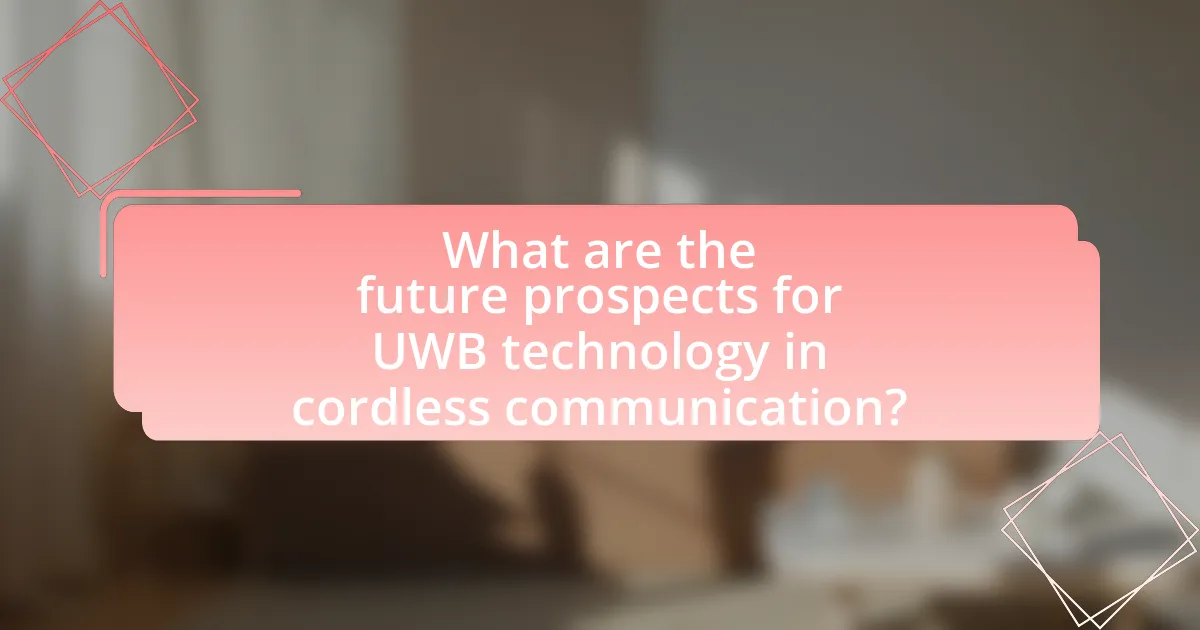The article focuses on the future trends in Ultra-Wideband (UWB) technology for cordless communication, highlighting its increasing adoption in consumer electronics, enhanced precision in location tracking, and integration with Internet of Things (IoT) devices. Key advancements include improved data transmission rates exceeding 1 Gbps and centimeter-level accuracy in positioning, making UWB suitable for applications in smart homes, automotive systems, and healthcare. The market for UWB technology is projected to grow significantly, driven by rising demand for high-speed data transfer and low-latency communication, with a compound annual growth rate (CAGR) of over 30% anticipated from 2021 to 2026. The article also addresses challenges such as regulatory hurdles and interoperability issues that UWB technology must overcome to realize its full potential in the cordless communication landscape.
-Technology-for-Cordless-Communication-1.webp)
What are the Future Trends in Ultra-Wideband (UWB) Technology for Cordless Communication?
Future trends in Ultra-Wideband (UWB) technology for cordless communication include increased adoption in consumer electronics, enhanced precision in location tracking, and integration with Internet of Things (IoT) devices. The growing demand for high-speed data transfer and low-latency communication is driving manufacturers to incorporate UWB in smartphones and wearables, as evidenced by Apple’s implementation of UWB in its iPhone models for features like AirTag tracking. Additionally, advancements in UWB chipsets are enabling more accurate indoor positioning systems, with accuracy levels reaching within centimeters, which is crucial for applications in smart homes and industrial automation. The market for UWB technology is projected to grow significantly, with estimates suggesting a compound annual growth rate (CAGR) of over 30% from 2021 to 2026, indicating a robust future for UWB in cordless communication.
How is UWB technology evolving in the context of cordless communication?
UWB technology is evolving in cordless communication by enhancing data transmission rates and improving location accuracy. Recent advancements have enabled UWB to support high-speed wireless connections, achieving data rates exceeding 1 Gbps, which is significantly faster than traditional Bluetooth and Wi-Fi technologies. Additionally, UWB’s precision ranging capabilities allow for accurate indoor positioning, with accuracy levels within 10 centimeters, making it ideal for applications like smart home devices and asset tracking. The integration of UWB in smartphones and IoT devices is also increasing, as manufacturers recognize its potential for seamless connectivity and enhanced user experiences.
What advancements are being made in UWB technology?
Advancements in Ultra-Wideband (UWB) technology include enhanced positioning accuracy, improved data transmission rates, and increased integration with Internet of Things (IoT) devices. Recent developments have demonstrated UWB’s capability to achieve centimeter-level accuracy in location tracking, which is significantly better than previous technologies. For instance, companies like Apple and Samsung are incorporating UWB in their devices for precise spatial awareness and seamless connectivity. Additionally, the IEEE 802.15.4z standard has been introduced, which enhances security and performance for UWB communications, allowing for more robust applications in smart homes and industrial automation. These advancements position UWB as a critical technology for future cordless communication systems.
How do these advancements impact cordless communication?
Advancements in Ultra-Wideband (UWB) technology significantly enhance cordless communication by providing higher data rates and improved accuracy in location tracking. UWB technology enables devices to transmit data over a wide frequency range, resulting in faster communication speeds that can exceed 1 Gbps, which is crucial for applications requiring real-time data transfer. Additionally, UWB’s precise positioning capabilities, with accuracy within centimeters, facilitate better device interaction and connectivity in smart environments. These improvements are validated by industry reports indicating that UWB technology can support multiple simultaneous connections without interference, thereby optimizing network efficiency and user experience in cordless communication systems.
What are the key applications of UWB technology in cordless communication?
The key applications of UWB technology in cordless communication include precise location tracking, high-speed data transfer, and secure communication. UWB enables accurate positioning systems, which are essential for applications like indoor navigation and asset tracking, achieving location accuracy within centimeters. Additionally, UWB supports data rates of up to 27 Mbps, facilitating fast wireless communication for devices such as smartphones and IoT gadgets. Furthermore, UWB’s low power consumption and resistance to interference enhance security in wireless communications, making it suitable for applications in smart homes and healthcare monitoring systems.
Which industries are adopting UWB technology for cordless communication?
The industries adopting UWB technology for cordless communication include automotive, healthcare, consumer electronics, and logistics. In the automotive sector, UWB is utilized for keyless entry systems and vehicle tracking, enhancing security and convenience. The healthcare industry employs UWB for real-time location systems (RTLS) to track medical equipment and patients, improving operational efficiency. Consumer electronics manufacturers integrate UWB for precise location services in smart devices, enabling features like spatial awareness and enhanced connectivity. Lastly, logistics companies leverage UWB for asset tracking and inventory management, optimizing supply chain operations. These applications demonstrate the growing relevance of UWB technology across multiple sectors.
How does UWB technology enhance user experience in these applications?
UWB technology enhances user experience in cordless communication applications by providing precise location tracking and high-speed data transfer. This precision allows for improved functionalities such as real-time asset tracking and seamless device connectivity, which are critical in environments like smart homes and industrial settings. For instance, UWB can achieve location accuracy within centimeters, significantly outperforming traditional technologies like Bluetooth and Wi-Fi. This capability not only facilitates efficient navigation and interaction with devices but also enhances security features, as UWB can enable secure access control based on proximity.
What challenges does UWB technology face in the future?
UWB technology faces several challenges in the future, including regulatory hurdles, interoperability issues, and competition from alternative technologies. Regulatory challenges arise from the need to comply with varying spectrum allocation rules across different regions, which can hinder widespread adoption. Interoperability issues stem from the integration of UWB with existing wireless technologies, requiring standardization to ensure seamless communication. Additionally, competition from technologies like Bluetooth and Wi-Fi 6, which offer similar functionalities, poses a threat to UWB’s market penetration. These challenges must be addressed to enable UWB technology to realize its full potential in cordless communication.
What regulatory hurdles must be overcome for UWB technology?
UWB technology must overcome several regulatory hurdles, primarily related to spectrum allocation and compliance with existing communication standards. The Federal Communications Commission (FCC) in the United States has established specific rules governing the use of UWB frequencies, which include limitations on power emissions to prevent interference with other wireless services. Additionally, UWB devices must adhere to regulations set by international bodies, such as the International Telecommunication Union (ITU), which dictate operational parameters and ensure compatibility with global communication systems. Compliance with these regulations is essential for manufacturers to gain market access and ensure the safe deployment of UWB technology in various applications.
How do technical limitations affect the adoption of UWB technology?
Technical limitations significantly hinder the adoption of Ultra-Wideband (UWB) technology by restricting its performance and compatibility with existing systems. For instance, UWB operates over a wide frequency range, which can lead to interference with other wireless technologies, complicating integration into current communication infrastructures. Additionally, the complexity of UWB hardware and the need for specialized components can increase costs and limit accessibility for manufacturers. According to a study by the IEEE, the lack of standardized protocols for UWB communication further exacerbates these challenges, making it difficult for developers to create universally compatible devices. These factors collectively slow down the widespread implementation of UWB technology in cordless communication applications.

How does UWB technology compare to other wireless communication technologies?
UWB technology offers superior precision and low power consumption compared to other wireless communication technologies such as Wi-Fi and Bluetooth. UWB can achieve location accuracy within centimeters, making it ideal for applications requiring precise positioning, unlike Wi-Fi, which typically offers accuracy within several meters, and Bluetooth, which generally provides less precision. Furthermore, UWB operates in a wider frequency range (3.1 to 10.6 GHz), allowing for higher data rates and reduced interference from other devices, which is a limitation in technologies like Bluetooth and Wi-Fi that operate in more congested frequency bands. This capability is supported by the IEEE 802.15.4a standard, which outlines UWB’s advantages in terms of data throughput and energy efficiency.
What advantages does UWB technology offer over traditional wireless technologies?
UWB technology offers superior accuracy in location tracking compared to traditional wireless technologies. It achieves centimeter-level precision, which is significantly better than the meter-level accuracy provided by Wi-Fi or Bluetooth. This high level of precision is due to UWB’s ability to transmit data over a wide frequency spectrum, allowing for more precise time-of-flight measurements. Additionally, UWB can support multiple devices simultaneously without interference, unlike traditional technologies that may struggle with congestion in crowded environments. These advantages make UWB particularly suitable for applications in smart homes, asset tracking, and proximity-based services.
How does UWB technology improve data transmission rates?
UWB technology improves data transmission rates by utilizing a wide frequency spectrum, allowing for high bandwidth communication. This capability enables UWB to transmit large amounts of data simultaneously over short distances with minimal interference. For instance, UWB can achieve data rates exceeding 1 Gbps, significantly outperforming traditional wireless technologies like Wi-Fi and Bluetooth, which typically operate on narrower frequency bands. The wideband nature of UWB also facilitates better multipath propagation, enhancing signal clarity and reliability, which further contributes to improved data transmission rates.
What role does UWB play in reducing latency in communication?
Ultra-Wideband (UWB) technology significantly reduces latency in communication by enabling high data transmission rates over short distances with minimal interference. UWB achieves this by utilizing a wide frequency spectrum, which allows for the simultaneous transmission of multiple signals, thereby decreasing the time required for data packets to travel between devices. Research indicates that UWB can achieve latency as low as 1 millisecond, making it suitable for applications requiring real-time communication, such as augmented reality and IoT devices. This low-latency performance is further supported by UWB’s ability to provide precise location tracking, which enhances the efficiency of data exchange in dynamic environments.
What are the limitations of UWB technology compared to other technologies?
UWB technology has limitations in range, penetration, and complexity compared to other wireless technologies. Specifically, UWB typically operates effectively over short distances, generally up to 10-30 meters, which is significantly less than technologies like Wi-Fi or cellular networks that can cover hundreds of meters. Additionally, UWB signals struggle to penetrate obstacles such as walls and furniture, leading to reduced performance in indoor environments compared to technologies like Bluetooth or Zigbee, which are designed for better penetration. Furthermore, UWB systems require more complex hardware and signal processing capabilities, making them more expensive and challenging to implement than simpler technologies like traditional RF communication.
How does range limitation affect UWB technology’s usability?
Range limitation significantly restricts the usability of Ultra-Wideband (UWB) technology by confining its effective operational distance, which typically spans up to 10-30 meters in indoor environments. This limitation impacts applications such as real-time location systems and high-speed data transfer, where extended range is often essential for seamless connectivity. For instance, in smart home applications, the inability to maintain reliable communication beyond a certain distance can hinder device interoperability and user experience. Thus, while UWB offers advantages like high precision and low power consumption, its range constraints can diminish its effectiveness in broader applications, necessitating advancements in range extension techniques to enhance its usability.
What are the implications of interference with other wireless signals?
Interference with other wireless signals can lead to degraded performance, reduced data rates, and increased latency in communication systems. This degradation occurs because overlapping frequencies can cause signal distortion, making it difficult for devices to accurately transmit and receive information. For instance, in environments where multiple wireless devices operate simultaneously, such as urban areas, the likelihood of interference increases, which can result in dropped connections or slower speeds. Studies have shown that in dense wireless environments, the effective throughput can decrease by up to 50% due to interference, highlighting the critical need for advanced interference mitigation techniques in future UWB technology developments.

What are the future prospects for UWB technology in cordless communication?
The future prospects for Ultra-Wideband (UWB) technology in cordless communication are highly promising, driven by its ability to provide high data rates, low power consumption, and precise location tracking. UWB technology is expected to enhance applications such as smart home devices, automotive systems, and industrial automation, where reliable and fast wireless communication is essential. According to a report by MarketsandMarkets, the UWB market is projected to grow from $1.2 billion in 2020 to $8.5 billion by 2025, indicating a compound annual growth rate (CAGR) of 47.5%. This growth is fueled by increasing demand for advanced wireless communication solutions and the integration of UWB in smartphones and IoT devices, which will further solidify its role in the future of cordless communication.
How is the market for UWB technology expected to grow?
The market for UWB technology is expected to grow significantly, with projections estimating a compound annual growth rate (CAGR) of approximately 30% from 2023 to 2030. This growth is driven by increasing demand for precise location tracking and high-speed data transfer in various applications, including automotive, consumer electronics, and industrial automation. According to a report by MarketsandMarkets, the UWB market was valued at around $1.2 billion in 2022 and is anticipated to reach $8.5 billion by 2030, highlighting the technology’s expanding adoption across multiple sectors.
What factors are driving the growth of UWB technology in the market?
The growth of UWB technology in the market is primarily driven by its high precision in location tracking and the increasing demand for advanced wireless communication solutions. UWB technology enables accurate positioning within centimeters, which is essential for applications in smart homes, automotive, and healthcare sectors. Additionally, the rise of the Internet of Things (IoT) and the need for efficient data transmission in crowded wireless environments further propel UWB adoption. According to a report by MarketsandMarkets, the UWB market is projected to grow from USD 1.2 billion in 2020 to USD 8.4 billion by 2025, reflecting a compound annual growth rate (CAGR) of 47.2%. This growth is supported by the technology’s ability to coexist with other wireless technologies, enhancing its appeal in diverse applications.
How do consumer trends influence the adoption of UWB technology?
Consumer trends significantly influence the adoption of UWB technology by driving demand for enhanced connectivity and location-based services. As consumers increasingly prioritize seamless experiences in smart devices, the need for precise positioning and low-latency communication becomes critical. For instance, the rise in smart home devices and wearables has created a market that values the capabilities of UWB, which offers advantages over traditional technologies like Bluetooth and Wi-Fi in terms of accuracy and energy efficiency. According to a report by MarketsandMarkets, the UWB market is projected to grow from $1.2 billion in 2020 to $8.4 billion by 2025, reflecting consumer interest in applications such as contactless payments and indoor navigation. This growth is further fueled by consumer preferences for innovative features that enhance usability and security, thereby accelerating the integration of UWB technology into mainstream products.
What innovations are on the horizon for UWB technology?
Innovations on the horizon for Ultra-Wideband (UWB) technology include enhanced positioning accuracy, improved data transfer rates, and integration with Internet of Things (IoT) devices. These advancements are driven by the demand for precise location tracking in applications such as smart homes and asset management. For instance, UWB can achieve centimeter-level accuracy, significantly surpassing traditional GPS systems, which typically operate within a few meters. Additionally, the development of UWB chipsets is expected to facilitate seamless communication between multiple devices, enhancing user experiences in smart environments. The ongoing research and deployment of UWB technology in various sectors, including automotive and healthcare, further validate its potential for transformative applications.
How might emerging technologies integrate with UWB technology?
Emerging technologies can integrate with Ultra-Wideband (UWB) technology by enhancing location accuracy and data transmission capabilities. For instance, advancements in artificial intelligence (AI) can optimize UWB signal processing, improving real-time tracking in smart environments. Additionally, the integration of Internet of Things (IoT) devices with UWB can facilitate seamless communication and interoperability among various smart devices, as UWB’s low power consumption and high precision make it ideal for IoT applications. Furthermore, the development of 5G networks can complement UWB by providing high-speed data transfer, enabling more robust applications in areas such as autonomous vehicles and smart cities. These integrations are supported by the growing adoption of UWB in consumer electronics, as seen in devices like smartphones and wearables, which leverage UWB for features like precise indoor navigation and secure device pairing.
What potential breakthroughs could enhance UWB technology’s capabilities?
Potential breakthroughs that could enhance UWB technology’s capabilities include advancements in antenna design, improved signal processing algorithms, and integration with artificial intelligence. Enhanced antenna designs can increase the range and accuracy of UWB signals, as demonstrated by research from the University of California, which showed that innovative antenna structures can significantly improve performance in dense environments. Improved signal processing algorithms can reduce interference and enhance data throughput, as evidenced by studies indicating that advanced algorithms can increase UWB data rates by up to 50%. Additionally, integrating artificial intelligence can optimize UWB systems for dynamic environments, allowing for real-time adjustments and improved user experiences, as highlighted in recent industry reports on smart communication systems.
What best practices should be followed when implementing UWB technology?
When implementing UWB technology, best practices include ensuring compliance with regulatory standards, optimizing network design for coverage and capacity, and conducting thorough site surveys. Compliance with standards such as IEEE 802.15.4a ensures interoperability and minimizes interference, which is crucial for reliable performance. Optimizing network design involves strategically placing UWB devices to maximize signal strength and minimize obstacles, enhancing overall communication efficiency. Conducting site surveys helps identify potential sources of interference and allows for adjustments in deployment to ensure robust connectivity. These practices are supported by industry guidelines and case studies demonstrating improved performance and user satisfaction in UWB deployments.
How can organizations ensure effective deployment of UWB technology?
Organizations can ensure effective deployment of UWB technology by conducting thorough site surveys to assess the environment and identify potential interference sources. This step is crucial as UWB operates in a crowded spectrum, and understanding the physical layout helps in optimizing the placement of UWB devices. Additionally, organizations should invest in training personnel on UWB technology and its applications, as knowledgeable staff can troubleshoot issues and maximize system performance.
Furthermore, implementing robust network management tools allows for real-time monitoring and adjustments, ensuring that the UWB system operates efficiently. According to a study by the IEEE, effective deployment strategies, including proper planning and continuous evaluation, can enhance the reliability and performance of UWB systems in various applications.
What common pitfalls should be avoided in UWB technology implementation?
Common pitfalls to avoid in UWB technology implementation include inadequate site surveys, which can lead to poor signal propagation and interference issues. Additionally, failing to account for environmental factors, such as obstacles and multipath effects, can significantly degrade performance. Another critical mistake is neglecting to ensure compatibility with existing systems, which can result in integration challenges. Lastly, underestimating the importance of regulatory compliance can lead to legal issues and operational setbacks. These pitfalls can hinder the effectiveness and reliability of UWB technology in cordless communication applications.


